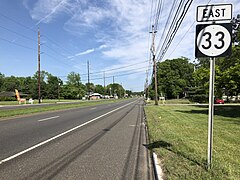Suburb

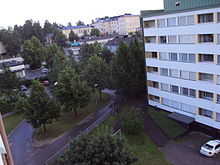
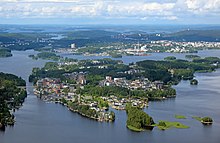
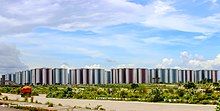
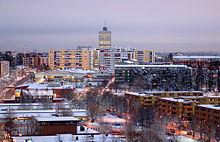
Asuburb(more broadlysuburban area) is an area within ametropolitan areawhich is predominantly residential and withincommutingdistance of a large city.[1]Suburbs can have their own political or legal jurisdiction, especially in the United States, but this is not always the case, especially in the United Kingdom, where most suburbs are located within the administrative boundaries of cities.[2]In mostEnglish-speaking countries,suburban areas are defined in contrast tocentral cityorinner cityareas, but inAustralian EnglishandSouth African English,suburbhas become largely synonymous with what is called a "neighborhood"in the U.S.[3]Due in part to historical trends such aswhite flight,some suburbs in the United States have a higher population and higher incomes than their nearby inner cities.[4][5][6][7][8]
In some countries, such as India, China, New Zealand, Canada, the United Kingdom, and parts of the United States, new suburbs are routinelyannexedby adjacent cities due tourban sprawl.In others, such asMorocco,France, and much of the United States, many suburbs remain separate municipalities or aregoverned locallyas part of a larger metropolitan area such as a county, district orborough.In the United States, regions beyond the suburbs are known as "exurban areas" orexurbs;exurbs have less population density than suburbs, but still more than rural areas. Suburbs and exurbs are sometimes linked to the nearby city economically, particularly by commuters.
Suburbs first emerged on a large scale in the 19th and 20th centuries as a result of improved rail and road transport, which led to an increase in commuting.[9]In general, they are less densely populated than inner city neighborhoods within the same metropolitan area, and most residents routinely commute to city centers orbusiness districtsviaprivate vehiclesorpublic transits;however, there are many exceptions, includingindustrial suburbs,planned communities,andsatellite cities.Suburbs tend to proliferate around cities that have an abundance of adjacent flat land.[10]
Etymology and usage[edit]
The English word is derived from theOld Frenchsubburbe,which is in turn derived from the Latinsuburbium,formed fromsub(meaning "under" or "below" ) andurbs( "city" ). The first recorded use of the term in English according to theOxford English Dictionary[11]appears inMiddle Englishc. 1350 in the manuscript of the Midlands Prose Psalter,[12]in which the formsuburbesis used.
Australia, New Zealand, and South Africa[edit]

In Australia, New Zealand and South Africa, suburban areas (in the wider sense noted in the lead paragraph) have become formalized as geographic subdivisions of a city and are used by postal services in addressing. In rural areas in both countries, their equivalents are called localities (seesuburbs and localities). The termsinner suburbandouter suburbare used to differentiate between the higher-density areas in proximity to the city center (which would not be referred to as 'suburbs' in most other countries), and the lower-density suburbs on the outskirts of the urban area. The term 'middle suburbs' is also used.Inner suburbs,such asTe Aroin Wellington,Eden Terracein Auckland,Prahranin Melbourne andUltimoin Sydney, are usually characterized by higher density apartment housing and greater integration between commercial and residential areas.
In New Zealand, most suburbs are not legally defined, which can lead to confusion as to where they may begin and end.[13]A geospatial dataset defining suburbs for use by emergency services is developed and maintained byFire and Emergency New Zealandand is published[14]under an open license.
North America[edit]
In theUnited StatesandCanada,suburbcan refer either to an outlying residential area of a city or town or to a separate municipality orunincorporated areaoutside a town or city.[citation needed]
Although a majority of Americans regard themselves as residents of suburban communities, the federal government of the United States has no formal definition for what constitutes asuburbin the United States, leaving its precise meaning disputed.[15][16]
In Canada, the term may also be used in the British sense, especially as cities annex formerly outlying areas.[citation needed]
United Kingdom and Ireland[edit]

In the United Kingdom and Ireland, the termsuburbsimply refers to a residential area outside the city center, regardless of administrative boundaries.[9]Suburbs, in this sense, can range from areas that seem more like residential areas of a city proper to areas separated by open countryside from the city center. In large cities such as London and Leeds, many suburbs are formerly separate towns and villages that have been absorbed during a city's expansion, such asEaling,Bromley,andGuiseley.In Ireland, this can be seen in the Dublin suburban areas of Swords,Blanchardstown,andTallaght.
History[edit]
The history of suburbia is part of the study ofurban history,which focuses on the origins, growth, diverse typologies, culture, and politics of suburbs, as well as on the gendered and family-oriented nature of suburban space.[17][18]Many people have assumed that early-20th-century suburbs were enclaves for middle-class whites, a concept that carries tremendous cultural influence yet is actually stereotypical. Some suburbs are based on a society of working-class and minority residents, many of whom want to own their own house. Meanwhile, other suburbs instituted "explicitly racist" policies to deter people deemed as "other", a practice most common in the United States in contrast to other countries around the world.[19]Mary Corbin Sies argues that it is necessary to examine how "suburb" is defined as well as the distinction made between cities and suburbs, geography, economic circumstances, and the interaction of numerous factors that move research beyond acceptance of stereotyping and its influence on scholarly assumptions.[20]
Early history[edit]
The earliest appearance of suburbs coincided with the spread of the first urban settlements. Large walled towns tended to be the focus around which smaller villages grew up in a symbiotic relationship with themarket town.The wordsuburbaniwas first employed by theRomanstatesmanCiceroin reference to the large villas and estates built by the wealthy patricians of Rome on the city's outskirts.
Towards the end of theEastern Han Dynasty,until 190 AD, whenDong Zhuorazed the city, the capitalLuoyangwas mainly occupied by the emperor and important officials; the city's people mostly lived in small cities right outside Luoyang, which were suburbs in all but name.[21]
As populations grew during theEarly Modern Periodin Europe, towns swelled with a steady influx of people from thecountryside.In some places, nearby settlements were swallowed up as the main city expanded. The peripheral areas on the outskirts of the city were generally inhabited by the very poorest.[22]
Origins of the modern suburb[edit]
Due to the rapid migration of the rural poor to the industrializing cities of England in the late 18th century, a trend in the opposite direction began to develop, whereby newly rich members of the middle classes began to purchase estates and villas on the outskirts of London. This trend accelerated through the 19th century, especially in cities like London andBirminghamthat were growing rapidly, and the first suburban districts sprung up around downtowns to accommodate those who wanted to escape the squalid conditions of the industrial towns. Initially, such growth came along rail lines in the form ofribbon developments,as suburban residents could commute via train to downtown for work. In Australia, where Melbourne would soon become the second-largest city in the British Empire,[23] the distinctively Australasian suburb, with its loosely aggregatedquarter-acresections, developed in the 1850s[24]and eventually became a component of theAustralian Dream.

Toward the end of the century, with the development of publictransitsystems such as theunderground railways,trams and buses, it became possible for the majority of a city's population to reside outside the city and to commute into the center for work.[22]
By the mid-19th century, the first major suburban areas were springing up around London as the city (then the largest in the world) became more overcrowded and unsanitary. A major catalyst for suburban growth was the opening of theMetropolitan Railwayin the 1860s. The line later joined the capital's financial heart inthe Cityto what were to become the suburbs ofMiddlesex.[25]The line reachedHarrowin 1880.
Unlike other railway companies, which were required to dispose of surplus land, London's Met was allowed to retain such land that it believed was necessary for future railway use.[note 1]Initially, the surplus land was managed by the Land Committee,[27]and, from the 1880s, the land was developed and sold to domestic buyers in places like Willesden Park Estate, Cecil Park, nearPinnerand at Wembley Park.
In 1912 it was suggested that a specially formed company should take over from the Surplus Lands Committee and develop suburban estates near the railway.[28]However,World War I(1914–1918) delayed these plans until 1919, when, with the expectation of a postwar housing-boom,[29]Metropolitan Railway Country Estates Limited(MRCE) formed. MRCE went on to develop estates atKingsbury Garden VillagenearNeasden,Wembley Park,Cecil Park and Grange Estate at Pinner and the Cedars Estate atRickmansworthand to found places such asHarrow Garden Village.[29][30]
The Met's marketing department coined the termMetro-landin 1915 when theGuide to the Extension Linebecame theMetro-landguide, priced at 1d.This promoted the land served by the Met for the walker, visitor and later the house-hunter.[28]Published annually until 1932 (the last full year of independence for the Met), the guide extolled the benefits of "The good air of the Chilterns", using language such as "Each lover of Metroland may well have his own favorite wood beech and coppice — all tremulous green loveliness in Spring and russet and gold in October".[31]The dream as promoted involved a modern home in beautiful countryside with a fast railway-service to central London.[32]By 1915 people from across London had flocked to live the new suburban dream in large newly built areas across north-west London.[33]
Interwar suburban expansion in England[edit]
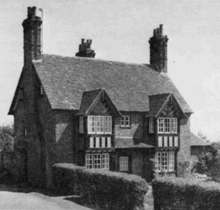
Suburbanization in the interwar period was heavily influenced by thegarden city movementofEbenezer Howardand the creation of the first garden suburbs at the turn of the 20th century.[34]The first garden suburb was developed through the efforts ofsocial reformerHenrietta Barnettand her husband; inspired by Ebenezer Howard and the model housing development movement (then exemplified byLetchworthgarden city), as well as the desire to protect part ofHampstead Heathfrom development, they established trusts in 1904 which bought 243 acres of land along the newly opened Northern line extension toGolders Greenand created theHampstead Garden Suburb.The suburb attracted the talents of architects includingRaymond Unwinand SirEdwin Lutyens,and it ultimately grew to encompass over 800 acres.[35]
During World War I, theTudor Walters Committeewas commissioned to make recommendations for the post war reconstruction and housebuilding. In part, this was a response to the shocking lack of fitness amongst many recruits during World War One, attributed to poor living conditions; a belief summed up in a housing poster of the period "you cannot expect to get an A1 population out of C3 homes" – referring to military fitness classifications of the period.
The committee's report of 1917 was taken up by the government, which passed theHousing, Town Planning, &c. Act 1919,also known as the Addison Act afterChristopher Addison,the then Minister for Housing. The Act allowed for the building of large new housing estates in the suburbs after theFirst World War,[36]and marked the start of a long 20th century tradition of state-owned housing, which would later evolve intocouncil estates.
The Report also legislated on the required, minimum standards necessary for further suburban construction; this included regulation on the maximum housing density and their arrangement, and it even made recommendations on the ideal number of bedrooms and other rooms per house. Although thesemi-detachedhouse was first designed by theShaws(a father and son architectural partnership) in the 19th century, it was during the suburban housing boom of the interwar period that the design first proliferated as a suburban icon, being preferred by middle-class home owners to the smallerterraced houses.[37]The design of many of these houses, highly characteristic of the era, was heavily influenced by theArt Decomovement, taking influence fromTudor Revival,chalet style,and even ship design.
Within just a decade suburbs dramatically increased in size.Harrow Wealdwent from just 1,500 to over 10,000 while Pinner jumped from 3,000 to over 20,000. During the 1930s, over 4 million new suburban houses were built, the 'suburban revolution' had made England the most heavily suburbanized country in the world, by a considerable margin.[9]
North America[edit]
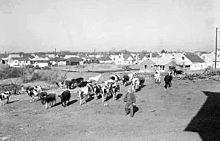
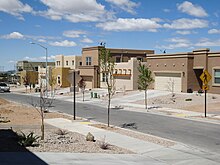

BostonandNew York Cityspawned the first major suburbs. The streetcar lines in Boston and the rail lines in Manhattan made daily commutes possible.[38]No metropolitan area in the world was as well served by railroad commuter lines at the turn of the twentieth century as New York, and it was the rail lines to Westchester from the Grand Central Terminal commuter hub that enabled its development. Westchester's true importance in the history of American suburbanization derives from the upper-middle class development of villages includingScarsdale,New RochelleandRyeserving thousands of businessmen and executives from Manhattan.[39]
Postwar suburban expansion[edit]
The suburban population in North America exploded during thepost-World War II economic expansion.Returning veterans wishing to start a settled life moved in masses to the suburbs.Levittowndeveloped as a major prototype of mass-produced housing. Due to the influx of people in these suburban areas, the amount of shopping centers began to increase as suburban America took shape. These malls helped supply goods and services to the growing urban population. Shopping for different goods and services in one central location without having to travel to multiple locations, helped to keep shopping centers a component of these newly designed suburbs which were booming in population. The television helped contribute to the rise of shopping centers by allowing for additional advertisement through the medium in addition to creating a desire among consumers to buy products that are shown being used in suburban life on various television programs. Another factor that led to the rise of these shopping centers was the building of many highways. The Highway Act of 1956 helped to fund the building of 64,000 kilometers across the nation by having 26 billion dollars on hand, which helped to link many more to these shopping centers with ease.[40]These newly built shopping centers, which were often large buildings full of multiple stores, and services, were being used for more than shopping, but as a place of leisure and a meeting point for those who lived within suburban America at this time. These centers thrived offering goods and services to the growing populations in suburban America. In 1957, 940 shopping centers were built and this number more than doubled by 1960 to keep up with the demand of these densely populated areas.[41]
Housing[edit]


Very little housing had been built during theGreat DepressionandWorld War II,except for emergency quarters near war industries. Overcrowded and inadequate apartments was the common condition. Some suburbs had developed around large cities where there was rail transportation to the jobs downtown. However, the real growth in suburbia depended on the availability of automobiles, highways, and inexpensive housing. The population had grown, and the stock of family savings had accumulated the money for down payments, automobiles and appliances. The product was a great housing boom. Whereas an average of 316,000 new non-farm housing units were constructed from the 1930s through 1945, there were 1,450,000 constructed annually from 1946 through 1955.[42]TheG.I. Billguaranteed low-cost loans for veterans, with very low down payments, and low interest rates.
With 16 million eligible veterans, the opportunity to buy a house was suddenly at hand. In 1947 alone, 540,000 veterans bought one; their average price was $7300. The construction industry kept prices low by standardization—for example, standardizing sizes for kitchen cabinets, refrigerators and stoves allowed for mass production of kitchen furnishings. Developers purchased empty land just outside the city, installed tract houses based on a handful of designs, and provided streets and utilities, while local public officials raced to build schools.[43]The most famous development was Levittown, in Long Island just east of New York City. It offered a new house for $1000 down and $70 a month; it featured three bedrooms, a fireplace, a gas range and gas furnace, and a landscaped lot of 75 by 100 feet, all for a total price of $10,000. Veterans could get one with a much lower down payment.[44]
At the same time, African Americans wererapidly moving north and westfor better jobs and educational opportunities than were available to them in the segregated South. Their arrival in Northern and Western cities en masse, in addition to being followed by race riots in several large cities such asPhiladelphia,Los Angeles,Detroit,Chicago,andWashington, D.C.,further stimulated white suburban migration. The growth of the suburbs was facilitated by the development ofzoninglaws,redliningand numerous innovations in transport. Redlining and other discriminatory measures built into federal housing policy furthered the racial segregation of postwar America–for example, by refusing to insure mortgages in and near African-American neighborhoods. The government's efforts were primarily designed to provide housing to White middle-class and lower-middle-class families. African Americans and other people of color largely remained concentrated within decaying cores of urban poverty creating a phenomenon known aswhite flight.[45]
After World War II, the availability ofFHA loansstimulated a housing boom in American suburbs. In the older cities of the northeast U.S.,streetcar suburbsoriginally developed along train ortrolleylines that could shuttle workers into and out of city centers where the jobs were located. This practice gave rise to the term "bedroom community",meaning that most daytime business activity took place in the city, with the working population leaving the city at night for the purpose of going home to sleep.
Economic growth in the United States encouraged the suburbanization of American cities that required massive investments for the new infrastructure and homes. Consumer patterns were also shifting at this time, as purchasing power was becoming stronger and more accessible to a wider range of families. Suburban houses also brought about needs for products that were not needed in urban neighborhoods, such as lawnmowers and automobiles. During this time commercial shopping malls were being developed near suburbs to satisfy consumers' needs and their car–dependent lifestyle.[46]
Zoning laws also contributed to the location of residential areas outside of the city center by creating wide areas or "zones" where only residential buildings were permitted. These suburban residences are built on larger lots of land than in the central city. For example, the lot size for a residence in Chicago is usually 125 feet (38 m) deep,[47]while the width can vary from 14 feet (4.3 m) wide for a row house to 45 feet (14 m) wide for a large stand–alone house.[citation needed]In the suburbs, where stand–alone houses are the rule, lots may be 85 feet (26 m) wide by 115 feet (35 m) deep, as in the Chicago suburb ofNaperville.[citation needed]Manufacturing and commercial buildings were segregated in other areas of the city.
Alongside suburbanization, many companies began locating their offices and other facilities in the outer areas of the cities, which resulted in the increased density of older suburbs and the growth of lower density suburbs even further from city centers. An alternative strategy is the deliberate design of "new towns" and the protection ofgreen beltsaround cities. Some social reformers attempted to combine the best of both concepts in the garden city movement.[48]
In the U.S., 1950 was the first year that more people lived in suburbs than elsewhere.[49]In the U.S., the development of the skyscraper and the sharp inflation of downtown real estate prices also led to downtowns being more fully dedicated to businesses, thus pushing residents outside the city center.
Worldwide[edit]

While suburbs are often associated with the middle classes, in many parts of the developed world, suburbs can be economically distressed areas, inhabited by higher proportions of recent immigrants, with higher delinquency rates and social problems, reminiscent of theinner citiesof the U.S. Examples include thebanlieuesof France, or theconcrete suburbsof Sweden, even if the suburbs of these countries also include middle-class and upper-class neighborhoods that often consist ofsingle-family houses.
Africa[edit]
Following the growth of the middle class due to African industrialization, the development of middle class suburbs has boomed since the beginning of the 1990s, particularly in cities such asCairo,Nairobi,Johannesburg,andLagos.
In an illustrative case of South Africa,RDPhousing has been built. In much ofSoweto,many houses are American in appearance, but are smaller, and often consist of a kitchen and living room, two or three bedrooms, and a bathroom. However, there are more affluent neighborhoods, more comparable to American suburbs, particularly east of theFNB ( "Soccer City" ) Stadiumand south of the city in areas like Eikenhof, where the "Eye of Africa" planned community exists.[50]This master-planned community is nearly indistinguishable from the most amenity-rich resort-style American suburbs in Florida, Arizona, and California, complete with a golf course, resort pool,equestrian facility,24-hour staffed gates, gym, and BMX track, as well as several tennis, basketball, and volleyball courts.[51]
In Cape Town, there is a distinct European style originating from European influence during the mid-1600s when the Dutch settled the Cape. Houses like these are called Cape Dutch Houses and can be found in the affluent suburbs ofConstantiaandBishopscourt.
Australia[edit]
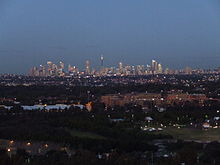
The Australian usage came about as outer areas were quickly surrounded in fast-growing cities, but retained the appellationsuburb;the term was eventually applied to the original core as well. In Australia, Sydney's urban sprawl has occurred predominantly in theWestern Suburbs.The locality ofOlympic Parkwas designated an official suburb in 2009.[52]
Bangladesh[edit]
Bangladesh has multiple suburbs,Uttara&Ashuliato name a few. However, most suburbs in Dhaka are different from the ones inEurope&Americas.Most suburbs inBangladeshare filled with high-rise buildings, paddy fields, and farms, and are designed more like rural villages.
Canada[edit]

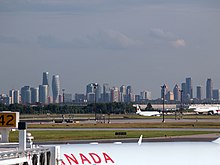
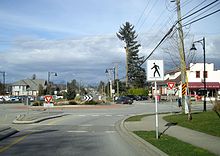
Canada is an urbanized nation where over 80% of the population lives in urban areas (loosely defined), and roughly two-thirds live in one of Canada's 33census metropolitan areas(CMAs) with a population of over 100,000. However, of this metropolitan population, in 2001 nearly half lived in low-density neighborhoods, with only one in five living in a typical "urban" neighborhood. The percentage living in low-density neighborhoods varied from a high of nearly two-thirds ofCalgary CMAresidents (67%), to a low of about one-third ofMontréal CMAresidents (34%).
Often, Canadian suburbs are less automobile-centric, andpublic transituse is encouraged but can be notably unused.[53]Throughout Canada, there are comprehensive plans in place to curb sprawl.
Population and income growth in Canadian suburbs had tended to outpace growth in core urban or rural areas, but in many areas, this trend has now reversed. The suburban population increased by 87% between 1981 and 2001, well ahead of urban growth.[54]The majority of recent population growth in Canada's three largest metropolitan areas (Greater Toronto,Greater Montréal, andGreater Vancouver) has occurred in non-core municipalities. This trend is also beginning to take effect inVancouver,and to a lesser extent,Montréal.In certain cities, particularlyEdmontonandCalgary,suburban growth takes place within the city boundaries as opposed to in bedroom communities. This is due to annexation and a large geographic footprint within the city borders.
Calgary is unusual among Canadian cities because it has developed as aunicity– it has annexed most of its surrounding towns and large amounts of undeveloped land around the city. As a result, most of the communities that Calgarians refer to as "suburbs" are actually inside the city limits.[55]In the 2016 census, the City of Calgary had a population of 1,239,220, whereas the Calgary Metropolitan Area had a population of 1,392,609, indicating the vast majority of people in the Calgary CMA lived within the city limits. The perceived low population density of Calgary largely results from its many internal suburbs and the large amount of undeveloped land within the city. The city actually has a policy of densifying its new developments.[56]
China[edit]

In China, the term suburb is new, although suburbs are already being constructed rapidly. Chinese suburbs mostly consist of rows upon rows ofapartment blocksand condos that end abruptly into the countryside.[57][58]Also new town developments are extremely common. Single family suburban homes tend to be similar to their Western equivalents; although primarily outside Beijing and Shanghai, also mimic Spanish and Italian architecture.[59]
Hong Kong[edit]
In Hong Kong, however, suburbs are mostly government-planned new towns containing numerous public housing estates. However, other new towns also contain private housing estates and low density developments for the upper classes.
Italy[edit]
In the illustrative case of Rome, Italy, in the 1920s and 1930s, suburbs were intentionally createdex novoto give lower classes a destination, in consideration of the actual and foreseen massive arrival of poor people from other areas of the country. Many critics have seen in this development pattern (which was circularly distributed in every direction) also a quick solution to a problem ofpublic order(keeping the unwelcome poorest classes together with the criminals, in this way better controlled, comfortably remote from the elegant "official" town). On the other hand, the expected huge expansion of the town soon effectively covered the distance from the central town, and now those suburbs are completely engulfed by the main territory of the town. Other newer suburbs (calledexurbs) were created at a further distance from them.[citation needed]
Japan[edit]
In Japan, the construction of suburbs has boomed since the end of World War II and many cities are experiencing theurban sprawleffect.
Latin America[edit]
In Mexico, suburbs are generally similar to their United States counterparts. Houses are made in many different architectural styles which may be of European, American and International architecture and which vary in size. Suburbs can be found inGuadalajara,Mexico City,Monterrey,and most major cities.Lomas de Chapultepecis an example of an affluent suburb, although it is located inside the city and by no means is today a suburb in the strict sense of the word. In other countries, the situation is similar to that of Mexico, with many suburbs being built, most notably in Peru and Chile, which have experienced a boom in the construction of suburbs since the late 1970s and early 1980s. As the growth of middle-class and upper-class suburbs increased, low-class squatter areas have increased, most notably"lost cities"in Mexico,campamentosin Chile,barriadasin Peru,villa miseriasin Argentina,asentamientosin Guatemala andfavelasof Brazil.
Brazilian affluent suburbs are generally denser, more vertical and mixed in useinner suburbs.They concentrate infrastructure, investment and attention from the municipal seat and the best offer of mass transit. True sprawling towards neighboring municipalities is typically empoverished –periferia(the periphery,in the sense of it dealing withspatialmarginalization) –, with a very noticeable example being the rail suburbs ofRio de Janeiro– the North Zone, theBaixada Fluminense,the part of the West Zone associated with SuperVia's Ramal de Santa Cruz. These, in comparison with the inner suburbs, often prove to be remote, violentfood desertswith inadequate sewer structure coverage, saturated mass transit, more precarious running water, electricity and communication services, and lack of urban planning and landscaping, while also not necessarily qualifying as actualfavelasor slums. They often are former agricultural land or wild areas settled through squatting; suburbs grew and expanded due to the massrural exodusduring the years of the military dictatorship. This is particularly true ofSão Paulo,Rio de Janeiro andBrasília,which grew with migration from more distant and impoverished parts of the country and deal with overpopulation as a result.
Malaysia[edit]

In Malaysia, suburbs are common especially inKlang Valley,the largestconurbationin the country.[60]These suburbs also serve as major housing areas and commuter towns.Terraced houses,semi-detached houses andshophousesare common concepts in suburban planning. In certain places such asKlang,Subang JayaandPetaling Jaya,suburbs form the core. The latter one has been turned into asatellite cityofKuala Lumpur.Suburbs are also evident in other major conurbations in the country such asPenang Island(Butterworth,Bukit Mertajam),Johor Bahru(Skudai,Pasir Gudang),Ipoh(Simpang Pulai),Kota Melaka(Ayer Keroh),Kuching(Petra Jaya) andAlor Setar(Anak Bukit).
Russia[edit]
In Russia, until recently, the term suburb refers to high-rise residential apartments which usually consist of two bedrooms, one bathroom, a kitchen and a living room. However, since the beginning of the 21st century in Russia there has been a "cottage boom", as a result of which a huge number of cottage villages appeared in almost every city of the country (including Moscow), no different from the suburbs in western countries.[citation needed]
United Kingdom[edit]
In the United Kingdom suburbs are located between the exurbs and inner cities of ametropolitan area.The growth in the use of trains, and later cars and highways, increased the ease with which workers could have a job in the city whilecommutingin from the suburbs. In the United Kingdom, as mentioned above, railways stimulated the first mass exodus to the suburbs. The Metropolitan Railway, for example, was active in building and promoting its own housing estates in the north-west of London, consisting mostly of detached houses on large plots, which it then marketed as "Metro-land".[61]In the UK, the government is seeking to impose minimum densities on newly approved housing schemes in parts ofSouth East England.The goal is to "build sustainable communities" rather than housing estates. However, commercial concerns tend to delay the opening of services until a large number of residents have occupied the new neighborhood.
United States[edit]
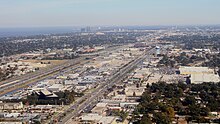
In the 20th century, many suburban areas, especially those not within the political boundaries of the city containing the central business area, began to see independence from the central city as an asset. In some cases, suburbanites saw self-government as a means to keep out people who could not afford the added suburban property maintenance costs not needed in city living. Federalsubsidiesfor suburban development accelerated this process as did the practice of redlining by banks and other lending institutions.[62]In some cities such asMiami,San Francisco,andWashington, D.C.,the main city is much smaller than the surrounding suburban areas, leaving the city proper with a small portion of the metro area's population and land area.
Mesa, Arizona,andVirginia Beach, Virginia,the two most populous suburbs in the U.S., are actually more populous than many core cities, including Miami,Minneapolis,New Orleans,Cleveland,Tampa,St. Louis,Pittsburgh,Cincinnati,and others. Virginia Beach is now the most populous city in Virginia, having long since exceeded the population of its neighboring primary city,Norfolk.While Virginia Beach has slowly been taking on the characteristics of an urban city, it will not likely achieve the population density and urban characteristics of Norfolk. A second suburban city in Virginia,Chesapeake,has also exceeded the population of adjacent Norfolk. With only a few large commercial areas and no definitive downtown area, Chesapeake is primarily residential in nature with vast rural areas remaining within the city limits.
Cleveland, Ohio, is typical of many American central cities; its municipal borders have changed little since 1922, even though the Cleveland urbanized area has grown many times over.[citation needed]Several layers of suburban municipalities now surround cities like Boston, Cleveland, Chicago, Detroit, Los Angeles, Dallas,Denver,Houston,New York City, San Francisco,Sacramento,Atlanta,Miami,Baltimore,Milwaukee,Pittsburgh, Philadelphia,Phoenix,Norfolk, St. Louis,Salt Lake City,Las Vegas,Minneapolis, and Washington, D.C..
Suburbs in the United States have a prevalence of usuallydetached[63]single-familyhomes.[64]
They are characterized by:
- Lowerdensitiesthan central cities, dominated by single-family homes on smallplots of land– anywhere from 0.1 acres[17]and up – surrounded at close quarters by very similar dwellings.
- Zoning patterns that separate residential and commercial development, as well as different intensities and densities of development. Daily needs are not within walking distance of most homes.
- A greater percentage ofwhites(bothnon-Hispanicand, in some areas,Hispanic) and lesser percentage of citizens ofother ethnic groupsthan in urban areas. However,blacksuburbanization grew between 1970 and 1980 by 2.6% as a result of central city neighborhoods expanding into older neighborhoods vacated by whites.[65][66][67]
- Subdivisionscarved from previously rural land into multiple-home developments built by a singlereal estate company.These subdivisions are oftensegregatedby minute differences in home value, creating entire communities where family incomes and demographics are almost completely homogeneous.[68]
- Shopping malls andstrip mallsbehind large parking lots instead of a classic downtownshopping district.
- A road network designed to conform to ahierarchy,including culs-de-sac, leading to larger residential streets, in turn leading to large collector roads, in place of thegrid patterncommon to most central cities and pre-World War II suburbs.
- A greater percentage of one-storyadministrative buildings than in urban areas.
- Compared to rural areas, suburbs usually have greater population density, higher standards of living, more complex road systems, more franchised stores and restaurants, and less farmland and wildlife.
By 2010, suburbs increasingly gained people in racial minority groups, as many members of minority groups gained better access to education and sought more favorable living conditions compared to inner city areas.[original research?][opinion]
Conversely, many white Americans also moved back to city centers. Nearly all major city downtowns (such asDowntown Miami,Downtown Detroit,Downtown Philadelphia,Downtown Roanoke,orDowntown Los Angeles) are experiencing a renewal, with large population growth, residential apartment construction, and increased social, cultural, and infrastructural investments, as have suburban neighborhoods close to city centers. Better public transit, proximity to work and cultural attractions, and frustration with suburban life andgridlockhave attracted young Americans to the city centers.[69]
Traffic flows[edit]
This section has multiple issues.Please helpimprove itor discuss these issues on thetalk page.(Learn how and when to remove these template messages)
|
Suburbs typically have longer travel times to work than traditional neighborhoods.[70]Only the trafficwithinthe short streets themselves is less. This is due to three factors:[citation needed]almost-mandatory automobile ownershipdue to poor suburbanbussystems and nearly-nonexistentrailsystems, longer travel distances and the hierarchy system, which is less efficient at distributing traffic than the traditionalgridof streets.
In the suburban system, most trips from one component to another component requires that cars enter acollector road[citation needed],no matter how short or long the distance is. This is compounded by the hierarchy of streets, where entire neighborhoods and subdivisions are dependent on one or two collector roads. Because all traffic is forced onto these roads, they are often heavy with traffic all day. If a traffic crash occurs on a collector road, or if road construction inhibits the flow, then the entire road system may be rendered useless until the blockage is cleared. The traditional "grown" grid, in turn, allows for a larger number of choices and alternate routes.
Suburban systems of the sprawl type are also quite inefficient for cyclists or pedestrians, as thedirect routeis usually not available for them either[citation needed].This encourages car trips even for distances as low as several hundreds of yards or meters (which may have become up to several miles or kilometers due to the road network). Improved sprawl systems, though retaining the cardetours,possesscycle pathsand footpaths connecting across the arms of thesprawlsystem, allowing a more direct route while still keeping the cars out of the residential and side streets.
More commonly, central cities seek ways to tax nonresidents working downtown – known as commuter taxes – as property tax bases dwindle. Taken together, these two groups of taxpayers represent a largely untapped source of potential revenue that cities may begin to target more aggressively, particularly if they're struggling. According to struggling cities, this will help bring in a substantial revenue for the city which is a great way to tax the people who make the most use of the highways and repairs.
Today more companies settle down in suburbs because of low property costs.
Criticism[edit]
In popular culture[edit]
This section has multiple issues.Please helpimprove itor discuss these issues on thetalk page.(Learn how and when to remove these template messages)
|
Suburbs and suburban living have been the subject for a wide variety of films, books, television shows and songs.
French songs likeLa ZonebyFréhel(1933),Aux quatre coins de la banlieuebyDamia(1936),Ma banlieuebyReda Caire(1937), orBanlieuebyRobert Lamoureux(1953), evoke the suburbs of Paris explicitly since the 1930s.[72]Those singers give a sunny festive, almost bucolic, image of the suburbs, yet still few urbanized. During the fifties and the sixties, French singer-songwriterLéo Ferréevokes in his songs popular and proletarian suburbs of Paris, to oppose them to the city, considered by comparison as a bourgeois and conservative place.
French cinemawas although soon interested in urban changes in the suburbs, with such movies asMon onclebyJacques Tati(1958),L'Amour existebyMaurice Pialat(1961) orTwo or Three Things I Know About HerbyJean-Luc Godard(1967).
In his one-act operaTrouble in Tahiti(1952),Leonard Bernsteinskewers American suburbia, which produces misery instead of happiness.
The AmericanphotojournalistBill Owensdocumented the culture of suburbia in the 1970s, most notably in his bookSuburbia.The 1962 song "Little Boxes"byMalvina Reynoldslampoons the development of suburbia and its perceivedbourgeoisandconformistvalues,[73]while the 1982 songSubdivisionsby the Canadian bandRushalso discusses suburbia, as doesRockin' the SuburbsbyBen Folds.The 2010 albumThe Suburbsby the Canadian-based alternative bandArcade Firedealt with aspects of growing up in suburbia, suggesting aimlessness, apathy and endless rushing are ingrained into the suburban culture and mentality.Suburb The Musical,was written by Robert S. Cohen and David Javerbaum.Over the Hedgeis a syndicated comic strip written and drawn by Michael Fry and T. Lewis. It tells the story of a raccoon, turtle, a squirrel, and their friends who come to terms with their woodlands being taken over by suburbia, trying to survive the increasing flow of humanity and technology while becoming enticed by it at the same time. A film adaptation ofOver the Hedgewas produced in 2006.
British television series such asThe Good Life,ButterfliesandThe Fall and Rise of Reginald Perrinhave depicted suburbia as well-manicured but relentlessly boring, and its residents as either overly conforming or prone to goingstir crazy.In contrast, U.S. shows such asKnots Landing,Desperate HousewivesandWeedsportray the suburbs as concealing darker secrets behind a façade of manicured lawns, friendly people, and beautifully kept houses. Films such asThe 'BurbsandDisturbiahave brought this theme to the cinema.
See also[edit]
Notes[edit]
- ^TheLands Clauses Consolidation Act 1845(8 & 9 Vict.c. 18) required railways to sell off surplus lands within ten years of the time given for completion of the work in the line's enabling Act.[26]
References[edit]
- ^Garreau, J.,Edge City: Life on the New Frontier,Knopf Doubleday, 1992, p149
- ^Caves, R. W. (2004).Encyclopedia of the City.Routledge. p. 640.ISBN9780415252256.
- ^Jain, Shri V. K. (30 April 2021).Applied Ecology and Sustainable Environment.BFC Publications.ISBN978-93-90880-19-5.
- ^"A forgotten history of how the US Government Segregated America".NPR.Retrieved30 November2023.
- ^"Demographics for 5 mile radius around Kansas City mo".demographics by radius.Retrieved28 November2023.
- ^"Demographics for a 5 mile radius around Overland Park Kansas".demograpbics by radius.Retrieved28 November2023.
- ^"Demographics for a 5 mile radius around Detroit".demographics by radius.Retrieved28 November2023.
- ^"Demographics for 5 mile radius around Southfield, Michigan".demographics by radius.Retrieved28 November2023.
- ^abcHollow, Matthew (2011)."Suburban Ideals on England's Interwar Council Estates".Journal of the Garden History Society.Retrieved29 December2012.
- ^The Fractured Metropolis: Improving the New City, Restoring the Old City, Reshaping the Region[permanent dead link]by Jonathan Barnett, via Google Books.
- ^"suburb, n."
- ^Psalter,British Library Add. MS. 17376, in Bülbring 1891, p. 188.
- ^"Suburb boundaries – a Official Information Act request to Christchurch City Council".FYI.30 March 2018. Archived fromthe originalon 20 April 2018.Retrieved20 April2018.
- ^"Fire and Emergency NZ Localities – Fire and Emergency NZ | | GIS Data Map Mapping | LINZ Data Service".data.linz.govt.nz.Retrieved21 September2021.
- ^Montgomery, David (7 July 2020)."How to Tell If You Live in the Suburbs".Bloomberg.com.
- ^Brasuell, James (21 November 2018)."According to the Federal Government, the Suburbs Don't Exist".Planetizen.
- ^abJackson 1985.
- ^Ruth McManus, and Philip J. Ethington (2007). "Suburbs in transition: new approaches to suburban history".Urban History.34(2): 317–337.doi:10.1017/S096392680700466X.S2CID146703204.
- ^Adams, L. J. (1 September 2006). "Sundown Towns: A Hidden Dimension of American Racism".Journal of American History.93(2): 601–602.doi:10.2307/4486372.ISSN0021-8723.JSTOR4486372.
- ^Mary Corbin Sies (2001). "North American Suburbs, 1880–1950".Journal of Urban History.27(3): 313–46.doi:10.1177/009614420102700304.S2CID144947126.
- ^"Luoyang and the Northern Army".Scholars of Shen Zhou.
- ^ab"History of Suburbs".Archivedfrom the original on 20 March 2020.Retrieved17 December2012.
- ^Goodman, Robin; Buxton, Michael; Moloney, Susie (2016). "The early development of Melbourne".Planning Melbourne: Lessons for a Sustainable City.CSIRO Publishing.ISBN9780643104747.Retrieved16 June2019.
By 1890, Melbourne was the second-largest city in the British Empire and one of the world's richest.
- ^
Gilbert, Alan (25 July 1989). "The Roots of Australian Anti-Suburbanism". In Goldberg, Samuels Louis; Smith, Francis Barrymore (eds.).Australian Cultural History(reprint ed.). Cambridge: CUP Archive (published 1988). p. 36.ISBN9780521356510.Retrieved26 March2021.
[...] there has been surprising continuity since the infancy of Australian suburbia in the 1850s in the attitudes, values and motives underlying suburbanization.
- ^Edwards, Dennis; Pigram, Ron (1988).The Golden Years of the Metropolitan Railway and the Metro-land Dream.Bloomsbury.p. 32.ISBN1-870630-11-4.
- ^Jackson 1986,p. 134.
- ^Jackson 1986,pp. 134, 137.
- ^abJackson 1986,p. 240.
- ^abGreen 1987,p. 43.
- ^Jackson 1986,pp. 241–242.
- ^Rowley 2006,pp. 206, 207.
- ^Green 2004,introduction.
- ^ "History of London Metro-Land and London's Suburbs".History.co.uk.Archived fromthe originalon 12 July 2013.Retrieved2 January2018.
- ^Clapson, Mark (2000). "The suburban aspiration in England since 1919".Contemporary British History.14:151–174.doi:10.1080/13619460008581576.S2CID143590157.
- ^"The History of the Suburb".Hgstrust.org.Archived fromthe originalon 3 January 2018.Retrieved2 January2018.
- ^"Outcomes of the War: Britain".Bbc.co.uk.Retrieved2 January2018.
- ^Lofthouse, Pamela (2012)."The Development of English Semi-detached Dwellings During the Nineteenth Century".Papers from the Institute of Archaeology.22:83–98.doi:10.5334/pia.404.
- ^Ward David (1964). "A Comparative Historical Geography of Streetcar Suburbs in Boston, Massachusetts and Leeds, England: 1850–1920".Annals of the Association of American Geographers.54(4): 477–489.doi:10.1111/j.1467-8306.1964.tb01779.x.
- ^Roger G. Panetta,Westchester: the American suburb(2006)
- ^"The Postwar Economy: 1945–1960 < Postwar America < History 1994 < American History From Revolution To Reconstruction and beyond".Let.rug.nl.Retrieved12 December2021.
- ^Cohen, Lizabeth (2003).A Consumer's Republic: The Politics of Mass Consumption in Postwar America.Vintage Books. pp. Chapter 6.
- ^U.S. Bureau of the Census,Historical Statistics of the United States(1976) series H-156
- ^Joseph Goulden,The Best Years, 1945–1950(1976) pp 135–39.
- ^Barbara Mae Kelly,Expanding the American Dream: Building and Rebuilding Levittown(SUNY Press, 1993).
- ^Rothstein, Richard: The Color of Law. A Forgotten History of How Our Government Segregated America, Liveright, 2017.
- ^Beauregard, Robert A. When America Became Suburban. Minneapolis, MN: University of Minnesota Press, 2006.
- ^"Zoning Requirements for Standard Lot in RS3 District".47th Ward Public Service website.Archived fromthe originalon 14 August 2014.Retrieved27 April2017.
- ^Garden Cities of To-Morrow.Library.cornell.edu. Retrieved on 22 November 2011.
- ^England, Robert E. and David R. Morgan.Managing Urban America,1979.
- ^"Eye of Africa".Eyeofafrica.co.za.2021.Retrieved9 October2021.
- ^"Eye of Africa".Eyeofafrica.co.za.2021.Retrieved9 October2021.
- ^"NSW Place and Road Naming Proposals System".proposals.gnb.nsw.gov.au.Retrieved24 January2022.
- ^"Dependence on cars in urban neighborhoods".Statistics Canada.Government of Canada. Archived fromthe originalon 17 September 2016.Retrieved27 April2017.
- ^The Wealthy Suburbs of Canada.Planetizen. Retrieved on 22 November 2011.
- ^"CALGARY, AB an overview of development trends"(PDF).Retrieved15 December2018.
- ^"THE CITY OF CALGARY Municipal Development Plan"(PDF).Retrieved15 December2018.
- ^"(Mis)understanding China's Suburbs".China Urban Development Blog. 23 February 2011.Retrieved25 February2013.
- ^"Is This Beijing's Suburban Future?".The Atlantic.10 February 2011.Retrieved25 February2013.
- ^Nasser, Haya El. (18 April 2008)Modern suburbia not just in America anymore.Usatoday.com. Retrieved on 22 November 2011.
- ^Aiken, S. Robert; Leigh, Colin H. (December 1975)."Malaysia's Emerging Conurbation".Annals of the Association of American Geographers.65(4): 546–563.doi:10.1111/j.1467-8306.1975.tb01062.x.JSTOR2562422.Retrieved24 June2023.
- ^London's metrolandArchived16 October 2007 at theWayback Machine.Transportdiversions.com. Retrieved on 22 November 2011.
- ^Comeback Cities: A Blueprint for Urban Neighborhood RevivalBy Paul S. Grogan, Tony Proscio.ISBN0-8133-3952-9.Published 2002. Page 142. "Perhaps suburbanization was a 'natural' phenomenon—rising incomes allowing formerly huddled masses in city neighborhoods to breathe free on green lawn and leafy culs-de-sac. But, we will never know how natural it was, because of the massive federal subsidy that eased and accelerated it, in the form of tax, transportation and housing policies."
- ^Land Development Calculations2001 Walter Martin Hosack. "single-family detached housing" = "suburb houses" p133
- ^"Housing Unit Characteristics by Type of Housing Unit, 2005"Energy Information Association
- ^Barlow, Andrew L. (2003).Between fear and hope: globalization and race in the United States.Lanham, Maryland (Prince George's County): Rowman & Littlefield.ISBN0-7425-1619-9.
- ^Noguera, Pedro (2003).City schools and the American dream: reclaiming the promise of public education.New York: Teachers College Press.ISBN0-8077-4381-X.
- ^Naylor, Larry L. (1999).Problems and issues of diversity in the United States.Westport, Conn.: Bergin & Garvey.ISBN0-89789-615-7.
- ^Miller, Carissa Moffat; Blevins, Audie (1 March 2005)."Battlement Mesa: a case study of community evolution".The Social Science Journal.42(1): 1–12.doi:10.1016/j.soscij.2004.11.001.ISSN0362-3319.S2CID143677128.
- ^Yen, Hope. "White flight? Suburbs lose young whites to cities."Associated PressatYahoo! News.Sunday 9 May 2010. Retrieved on 10 May 2010.
- ^Kneebone; Holmes, Elizabeth; Natalie."The growing distance between people and jobs in metropolitan America"(PDF).Bicycleuniverse.info.
{{cite web}}:CS1 maint: multiple names: authors list (link) - ^Boyd (1960).
- ^"Chanson francaise La banlieue 1931–1953 Anthologie".Fremeaux.com.Retrieved2 January2018.
- ^Keil, Rob (2006).Little Boxes: The Architecture of a Classic Midcentury Suburb.Daly City, CA: Advection Media.ISBN0-9779236-4-9.
Bibliography[edit]
- Archer, John; Paul J.P. Sandul, and Katherine Solomonson (eds.),Making Suburbia: New Histories of Everyday America.Minneapolis, MN: University of Minnesota Press, 2015.
- Baxandall, Rosalyn and Elizabeth Ewen.Picture Windows: How the Suburbs Happened.New York: Basic Books, 2000.
- Beauregard, Robert A.When America Became Suburban.University of Minnesota Press, 2006.
- Boyd, Robin (1960).The Australian Ugliness.Melbourne: Penguin Books.
- The Earliest Complete English Prose Salter,ed. by K. D. Bülbring. Early English Text Society, Original Series, 1891.
- Fishman, Robert.Bourgeois Utopias: The Rise and Fall of Suburbia.Basic Books, 1987; in U.S.
- Foxell, Clive (1996).Chesham Shuttle: The Story of a Metropolitan Branch Line(2nd ed.). Clive Foxell.ISBN0-9529184-0-4.
- Galinou, Mireille.Cottages and Villas: The Birth of the Garden Suburb(2011), in England
- Green, Oliver (1987).The London Underground: An illustrated history.Ian Allan.ISBN0-7110-1720-4.
- Green, Oliver, ed. (2004).Metro-Land(British Empire Exhibition 1924 reprinted ed.). Southbank Publishing.ISBN1-904915-00-0.Archived fromthe originalon 28 June 2008.Retrieved22 April2012.
- Harris, Richard.Creeping Conformity: How Canada Became Suburban, 1900–1960(2004)
- Hayden, Dolores.Building Suburbia: Green Fields and Urban Growth, 1820–2000.Vintage Books, 2003.
- Horne, Mike (2003).The Metropolitan Line.Capital Transport.ISBN1-85414-275-5.
- Jackson, Kenneth T.(1985),Crabgrass Frontier: The Suburbanization of the United States,New York:Oxford University Press,ISBN0-19-504983-7
- Jackson, Alan (1986).London's Metropolitan Railway.David & Charles.ISBN0-7153-8839-8.
- Psalter,London, British Library Add. MS. 17376
- Rowley, Trevor (2006).The English landscape in the twentieth century.Hambledon Continuum.ISBN1-85285-388-3.
- Simpson, Bill (2003).A History of the Metropolitan Railway. Volume 1: The Circle and Extended Lines to Rickmansworth.Lamplight Publications.ISBN1-899246-07-X.
- Stilgoe, John R.Borderland: Origins of the American Suburb, 1820–1939.Yale University Press, 1989.
- Teaford, Jon C.The American Suburb: The Basics.Routledge, 2008.


